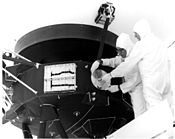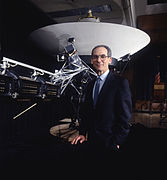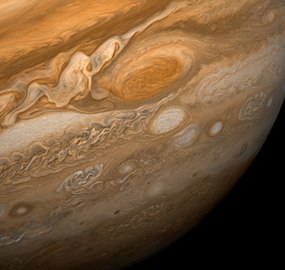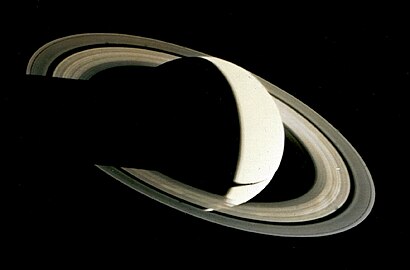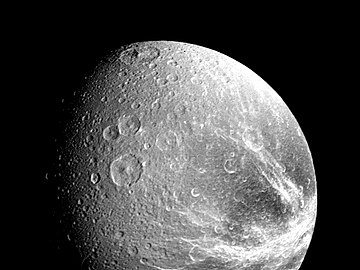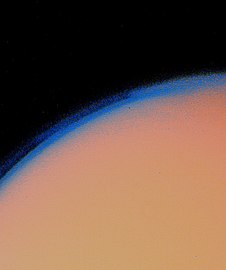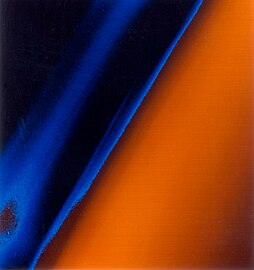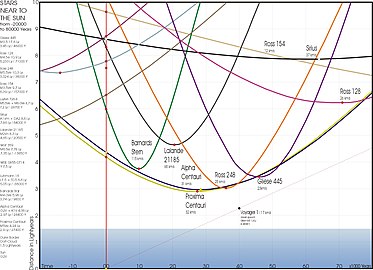cosmos.wikisort.org - Spacecraft
Voyager 1 is a space probe launched by NASA on September 5, 1977, as part of the Voyager program to study the outer Solar System and interstellar space beyond the Sun's heliosphere. Launched 16 days after its twin Voyager 2, Voyager 1 has been operating for 45 years, 2 months and 11 days as of November 16, 2022 UTC [refresh]. It communicates through NASA's Deep Space Network to receive routine commands and to transmit data to Earth. Real-time distance and velocity data is provided by NASA and JPL.[3] At a distance of 158.79 AU (14.760 billion mi) from Earth as of November 7, 2022[update],[3] it is the most distant man-made object from Earth.[4]
 Model of the Voyager spacecraft design | |
| Mission type | Outer planetary, heliosphere, and interstellar medium exploration |
|---|---|
| Operator | NASA / Jet Propulsion Laboratory |
| COSPAR ID | 1977-084A[1] |
| SATCAT no. | 10321[2] |
| Website | voyager |
| Mission duration |
|
| Spacecraft properties | |
| Spacecraft type | Mariner Jupiter-Saturn |
| Manufacturer | Jet Propulsion Laboratory |
| Launch mass | 825.5 kg (1,820 lb) |
| Power | 470 watts (at launch) |
| Start of mission | |
| Launch date | September 5, 1977, 12:56:00 UTC |
| Rocket | Titan IIIE |
| Launch site | Cape Canaveral Launch Complex 41 |
| End of mission | |
| Last contact | TBD |
| Flyby of Jupiter | |
| Closest approach | March 5, 1979 |
| Distance | 349,000 km (217,000 mi) |
| Flyby of Saturn | |
| Closest approach | November 12, 1980 |
| Distance | 124,000 km (77,000 mi) |
| Flyby of Titan (atmosphere study) | |
| Closest approach | November 12, 1980 |
| Distance | 6,490 km (4,030 mi) |
Flagship | |
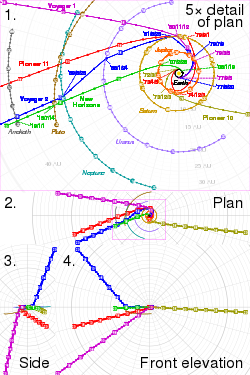
Plot 1 is viewed from the north ecliptic pole, to scale.
Plots 2 to 4 are third-angle projections at 20% scale.
In the SVG file, hover over a trajectory or orbit to highlight it and its associated launches and flybys.
The probe made flybys of Jupiter, Saturn, and Saturn's largest moon, Titan. NASA had a choice of either doing a Pluto or Titan flyby; exploration of the moon took priority because it was known to have a substantial atmosphere.[5][6][7] Voyager 1 studied the weather, magnetic fields, and rings of the two gas giants and was the first probe to provide detailed images of their moons.
As part of the Voyager program and like its sister craft Voyager 2, the spacecraft's extended mission is to locate and study the regions and boundaries of the outer heliosphere and to begin exploring the interstellar medium. Voyager 1 crossed the heliopause and entered interstellar space on August 25, 2012, making it the first spacecraft to do so.[8][9] Two years later, Voyager 1 began experiencing a third "tsunami wave" of coronal mass ejections from the Sun that continued to at least December 15, 2014, further confirming that the probe is indeed in interstellar space.[10]
In a further testament to the robustness of Voyager 1, the Voyager team tested the spacecraft's trajectory correction maneuver (TCM) thrusters in late 2017 (the first time these thrusters had been fired since 1980), a project enabling the mission to be extended by two to three years.[11] Voyager 1's extended mission is expected to continue until about 2025, when its radioisotope thermoelectric generators (RTGs) will no longer supply enough electric power to operate its scientific instruments.[12]
Mission background
History
In the 1960s, a Grand Tour to study the outer planets was proposed which prompted NASA to begin work on a mission in the early 1970s.[13] Information gathered by the Pioneer 10 spacecraft helped Voyager's engineers design Voyager to cope more effectively with the intense radiation environment around Jupiter.[14] However, shortly before launch, strips of kitchen-grade aluminum foil were applied to certain cabling to further enhance radiation shielding.[15]
Initially, Voyager 1 was planned as "Mariner 11" of the Mariner program. Due to budget cuts, the mission was scaled back to be a flyby of Jupiter and Saturn and renamed the Mariner Jupiter-Saturn probes. As the program progressed, the name was later changed to Voyager, since the probe designs began to differ greatly from previous Mariner missions.[16]
Spacecraft components

Voyager 1 was constructed by the Jet Propulsion Laboratory.[17][18][19] It has 16 hydrazine thrusters, three-axis stabilization gyroscopes, and referencing instruments to keep the probe's radio antenna pointed toward Earth. Collectively, these instruments are part of the Attitude and Articulation Control Subsystem (AACS), along with redundant units of most instruments and 8 backup thrusters. The spacecraft also included 11 scientific instruments to study celestial objects such as planets as it travels through space.[20]
Communication system
The radio communication system of Voyager 1 was designed to be used up to and beyond the limits of the Solar System. The communication system includes a 3.7-meter (12 ft) diameter high gain Cassegrain antenna to send and receive radio waves via the three Deep Space Network stations on the Earth.[21] The craft normally transmits data to Earth over Deep Space Network Channel 18, using a frequency of either 2.3 GHz or 8.4 GHz, while signals from Earth to Voyager are transmitted at 2.1 GHz.[22]
When Voyager 1 is unable to communicate directly with the Earth, its digital tape recorder (DTR) can record about 67 megabytes of data for transmission at another time.[23] As of 2021[update] signals from Voyager 1 take over 21 hours to reach Earth.[3]
Power
Voyager 1 has three radioisotope thermoelectric generators (RTGs) mounted on a boom. Each MHW-RTG contains 24 pressed plutonium-238 oxide spheres.[24] The RTGs generated about 470 W of electric power at the time of launch, with the remainder being dissipated as waste heat.[25] The power output of the RTGs declines over time due to the 87.7-year half-life of the fuel and degradation of the thermocouples, but the craft's RTGs will continue to support some of its operations until 2025.[20][24]
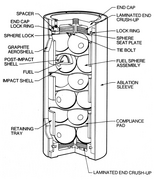 Diagram of RTG fuel container, showing the plutonium-238 oxide spheres
Diagram of RTG fuel container, showing the plutonium-238 oxide spheres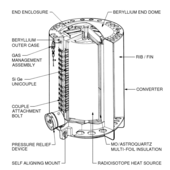 Diagram of RTG shell, showing the power-producing silicon-germanium thermocouples
Diagram of RTG shell, showing the power-producing silicon-germanium thermocouples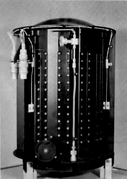 Model of an RTG unit
Model of an RTG unit
Computers
Unlike the other onboard instruments, the operation of the cameras for visible light is not autonomous, but rather it is controlled by an imaging parameter table contained in one of the on-board digital computers, the Flight Data Subsystem (FDS). Since the 1990s, most space probes have been equipped with completely autonomous cameras.[26]
The computer command subsystem (CCS) controls the cameras. The CCS contains fixed computer programs, such as command decoding, fault-detection and -correction routines, antenna pointing routines, and spacecraft sequencing routines. This computer is an improved version of the one that was used in the 1970s Viking orbiters.[27]
The Attitude and Articulation Control Subsystem (AACS) controls the spacecraft orientation (its attitude). It keeps the high-gain antenna pointing towards the Earth, controls attitude changes, and points the scan platform. The custom-built AACS systems on both Voyagers are the same.[28][29]
Scientific instruments
| Instrument name | Abr. | Description | ||||||||||||||||||||||||||||||||||||||||||||||||||||||||||||||||||||||||||||||||||||||||||||
|---|---|---|---|---|---|---|---|---|---|---|---|---|---|---|---|---|---|---|---|---|---|---|---|---|---|---|---|---|---|---|---|---|---|---|---|---|---|---|---|---|---|---|---|---|---|---|---|---|---|---|---|---|---|---|---|---|---|---|---|---|---|---|---|---|---|---|---|---|---|---|---|---|---|---|---|---|---|---|---|---|---|---|---|---|---|---|---|---|---|---|---|---|---|---|
| Imaging Science System (disabled) |
(ISS) | Utilized a two-camera system (narrow-angle/wide-angle) to provide images of Jupiter, Saturn and other objects along the trajectory. More
| ||||||||||||||||||||||||||||||||||||||||||||||||||||||||||||||||||||||||||||||||||||||||||||
| Radio Science System (disabled) |
(RSS) | Utilized the telecommunications system of the Voyager spacecraft to determine the physical properties of planets and satellites (ionospheres, atmospheres, masses, gravity fields, densities) and the amount and size distribution of material in Saturn's rings and the ring dimensions. More
| ||||||||||||||||||||||||||||||||||||||||||||||||||||||||||||||||||||||||||||||||||||||||||||
| Infrared Interferometer Spectrometer (disabled) |
(IRIS) | Investigates both global and local energy balance and atmospheric composition. Vertical temperature profiles are also obtained from the planets and satellites as well as the composition, thermal properties, and size of particles in Saturn's rings. More
| ||||||||||||||||||||||||||||||||||||||||||||||||||||||||||||||||||||||||||||||||||||||||||||
| Ultraviolet Spectrometer (disabled) |
(UVS) | Designed to measure atmospheric properties, and to measure radiation. More
| ||||||||||||||||||||||||||||||||||||||||||||||||||||||||||||||||||||||||||||||||||||||||||||
| Triaxial Fluxgate Magnetometer (active) |
(MAG) | Designed to investigate the magnetic fields of Jupiter and Saturn, the interaction of the solar wind with the magnetospheres of these planets, and the magnetic field of interplanetary space out to the boundary between the solar wind and the magnetic field of interstellar space. More
| ||||||||||||||||||||||||||||||||||||||||||||||||||||||||||||||||||||||||||||||||||||||||||||
| Plasma Spectrometer (defective) |
(PLS) | Investigates the microscopic properties of the plasma ions and measures electrons in the energy range from 5 eV to 1 keV. More
| ||||||||||||||||||||||||||||||||||||||||||||||||||||||||||||||||||||||||||||||||||||||||||||
| Low Energy Charged Particle Instrument (active) |
(LECP) | Measures the differential in energy fluxes and angular distributions of ions, electrons and the differential in energy ion composition. More
| ||||||||||||||||||||||||||||||||||||||||||||||||||||||||||||||||||||||||||||||||||||||||||||
| Cosmic Ray System (active) |
(CRS) | Determines the origin and acceleration process, life history, and dynamic contribution of interstellar cosmic rays, the nucleosynthesis of elements in cosmic-ray sources, the behavior of cosmic rays in the interplanetary medium, and the trapped planetary energetic-particle environment. More
| ||||||||||||||||||||||||||||||||||||||||||||||||||||||||||||||||||||||||||||||||||||||||||||
| Planetary Radio Astronomy Investigation (disabled) |
(PRA) | Utilizes a sweep-frequency radio receiver to study the radio-emission signals from Jupiter and Saturn. More
| ||||||||||||||||||||||||||||||||||||||||||||||||||||||||||||||||||||||||||||||||||||||||||||
| Photopolarimeter System (defective) |
(PPS) | Utilized a telescope with a polarizer to gather information on surface texture and composition of Jupiter and Saturn and information on atmospheric scattering properties and density for both planets. More
| ||||||||||||||||||||||||||||||||||||||||||||||||||||||||||||||||||||||||||||||||||||||||||||
| Plasma Wave Subsystem (active) |
(PWS) | Provides continuous, sheath-independent measurements of the electron-density profiles at Jupiter and Saturn as well as basic information on local wave–particle interaction, useful in studying the magnetospheres. More
| ||||||||||||||||||||||||||||||||||||||||||||||||||||||||||||||||||||||||||||||||||||||||||||
For more details on the Voyager space probes' identical instrument packages, see the separate article on the overall Voyager Program.
Mission profile
Timeline of travel
 Voyager 1's trajectory seen from Earth, diverging from the ecliptic in 1981 at Saturn and now heading into the constellation Ophiuchus |
| Date | Event |
|---|---|
| 1977-09-05 | Spacecraft launched at 12:56:00 UTC. |
| 1977-12-10 | Entered asteroid belt. |
| 1977-12-19 | Voyager 1 overtakes Voyager 2. (see diagram) |
| 1978-09-08 | Exited asteroid belt. |
| 1979-01-06 | Start Jupiter observation phase. |
| 1979-03-05 | Encounter with the Jovian system. |
| 06:54 | Amalthea flyby at 420,200 km. |
| 12:05:26 | Jupiter closest approach at 348,890 km from the center of mass. |
| 15:14 | Io flyby at 20,570 km. |
| 18:19 | Europa flyby at 733,760 km. |
| 1979-03-06 | |
| 02:15 | Ganymede flyby at 114,710 km. |
| 17:08 | Callisto flyby at 126,400 km. |
| 1979-04-13 | Phase end |
| 1980-08-22 | Start Saturn observation phase. |
| 1980-11-12 | Encounter with the Saturnian system. |
| 05:41:21 | Titan flyby at 6,490 km. |
| 22:16:32 | Tethys flyby at 415,670 km. |
| 23:46:30 | Saturn closest approach at 184,300 km from the center of mass. |
| 1980-11-13 | |
| 01:43:12 | Mimas flyby at 88,440 km. |
| 01:51:16 | Enceladus flyby at 202,040 km. |
| 06:21:53 | Rhea flyby at 73,980 km. |
| 16:44:41 | Hyperion flyby at 880,440 km. |
| 1980-11-14 | Phase end |
| 1980-11-14 | Begin extended mission. |
| Extended mission | |
|---|---|
| 1990-02-14 | Final images of the Voyager program acquired by Voyager 1 to create the Solar System Family Portrait. |
| 1998-02-17 | Voyager 1 overtakes Pioneer 10 as the most distant spacecraft from the Sun, at 69.419 AU. Voyager 1 is moving away from the Sun at over 1 AU per year faster than Pioneer 10. |
| 2004-12-17 | Passed the termination shock at 94 AU and entered the heliosheath. |
| 2007-02-02 | Terminated plasma subsystem operations. |
| 2007-04-11 | Terminated plasma subsystem heater. |
| 2008-01-16 | Terminated planetary radio astronomy experiment operations. |
| 2012-08-25 | Crossed the heliopause at 121 AU and entered interstellar space. |
| 2014-07-07 | Further confirmation probe is in interstellar space. |
| 2016-04-19 | Terminated Ultraviolet Spectrometer operations. |
| 2017-11-28 | "Trajectory correction maneuver" (TCM) thrusters are tested in their first use since November 1980.[32] |
| 2022-07-14 | Voyager 1 has reached a distance of 23.381 billion km (14.528 billion mi; 156.29 AU) from Earth and 23.483 billion km (14.592 billion mi; 156.97 AU) from the Sun.[33] |
Launch and trajectory

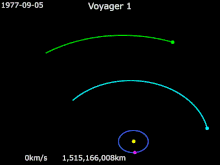
Voyager 1 · Earth · Jupiter · Saturn · Sun
The Voyager 1 probe was launched on September 5, 1977, from Launch Complex 41 at the Cape Canaveral Air Force Station, aboard a Titan IIIE launch vehicle. The Voyager 2 probe had been launched two weeks earlier, on August 20, 1977. Despite being launched later, Voyager 1 reached both Jupiter[34] and Saturn sooner, following a shorter trajectory.[35]
Voyager 1's initial orbit had an aphelion of 8.9 AU (830 million mi), just a little short of Saturn's orbit of 9.5 AU (880 million mi). Voyager 2's initial orbit had an aphelion of 6.2 AU (580 million mi), well short of Saturn's orbit.[36]
Flyby of Jupiter

Voyager 1 · Jupiter · Io · Europa · Ganymede · Callisto

Voyager 1 began photographing Jupiter in January 1979. Its closest approach to Jupiter was on March 5, 1979, at a distance of about 349,000 kilometers (217,000 miles) from the planet's center.[34] Because of the greater photographic resolution allowed by a closer approach, most observations of the moons, rings, magnetic fields, and the radiation belt environment of the Jovian system were made during the 48-hour period that bracketed the closest approach. Voyager 1 finished photographing the Jovian system in April 1979.[37]
The discovery of ongoing volcanic activity on the moon Io was probably the greatest surprise. It was the first time active volcanoes had been seen on another body in the Solar System. It appears that activity on Io affects the entire Jovian system. Io appears to be the primary source of matter that pervades the Jovian magnetosphere – the region of space that surrounds the planet influenced by the planet's strong magnetic field. Sulfur, oxygen, and sodium, apparently erupted by Io's volcanoes and sputtered off the surface by the impact of high-energy particles, were detected at the outer edge of the magnetosphere of Jupiter.[34]
The two Voyager space probes made a number of important discoveries about Jupiter, its satellites, its radiation belts, and its never-before-seen planetary rings.
- Voyager 1 time-lapse movie of Jupiter approach (full-size video)
- Jupiter's Great Red Spot, an anti-cyclonic storm larger than Earth, as seen from Voyager 1
- View of sulfur-rich lava flows radiating from the volcano Ra Patera on Io
- Europa's lineated but un-cratered face, evidence of currently active geology, at a distance of 2.8 million km.
- Ganymede's tectonically disrupted surface, marked with bright impact sites, from 253,000 km.
Flyby of Saturn

Voyager 1 · Saturn · Mimas · Enceladus · Tethys · Rhea · Titan
The gravitational assist trajectories at Jupiter were successfully carried out by both Voyagers, and the two spacecraft went on to visit Saturn and its system of moons and rings. Voyager 1 encountered Saturn in November 1980, with the closest approach on November 12, 1980, when the space probe came within 124,000 kilometers (77,000 mi) of Saturn's cloud-tops. The space probe's cameras detected complex structures in the rings of Saturn, and its remote sensing instruments studied the atmospheres of Saturn and its giant moon Titan.[38]
Voyager 1 found that about seven percent of the volume of Saturn's upper atmosphere is helium (compared with 11 percent of Jupiter's atmosphere), while almost all the rest is hydrogen. Since Saturn's internal helium abundance was expected to be the same as Jupiter's and the Sun's, the lower abundance of helium in the upper atmosphere may imply that the heavier helium may be slowly sinking through Saturn's hydrogen; that might explain the excess heat that Saturn radiates over energy it receives from the Sun. Winds blow at high speeds on Saturn. Near the equator, the Voyagers measured winds about 500 m/s (1,100 mph). The wind blows mostly in an easterly direction.[35]
The Voyagers found aurora-like ultraviolet emissions of hydrogen at mid-latitudes in the atmosphere, and auroras at polar latitudes (above 65 degrees). The high-level auroral activity may lead to the formation of complex hydrocarbon molecules that are carried toward the equator. The mid-latitude auroras, which occur only in sunlit regions, remain a puzzle, since bombardment by electrons and ions, known to cause auroras on Earth, occurs primarily at high latitudes. Both Voyagers measured the rotation of Saturn (the length of a day) at 10 hours, 39 minutes, 24 seconds.[38]
Voyager 1's mission included a flyby of Titan, Saturn's largest moon, which had long been known to have an atmosphere. Images taken by Pioneer 11 in 1979 had indicated the atmosphere was substantial and complex, further increasing interest. The Titan flyby occurred as the spacecraft entered the system to avoid any possibility of damage closer to Saturn compromising observations, and approached to within 6,400 km (4,000 mi), passing behind Titan as seen from Earth and the Sun. Voyager's measurement of the atmosphere's effect on sunlight and Earth-based measurement of its effect on the probe's radio signal were used to determine the atmosphere's composition, density, and pressure. Titan's mass was also measured by observing its effect on the probe's trajectory. The thick haze prevented any visual observation of the surface, but the measurement of the atmosphere's composition, temperature, and pressure led to speculation that lakes of liquid hydrocarbons could exist on the surface.[39]
Because observations of Titan were considered vital, the trajectory chosen for Voyager 1 was designed around the optimum Titan flyby, which took it below the south pole of Saturn and out of the plane of the ecliptic, ending its planetary science mission.[40] Had Voyager 1 failed or been unable to observe Titan, Voyager 2's trajectory would have been altered to incorporate the Titan flyby,[39]: 94 precluding any visit to Uranus and Neptune.[5] The trajectory Voyager 1 was launched into would not have allowed it to continue on to Uranus and Neptune,[40]: 155 but could have been altered to avoid a Titan flyby and travel from Saturn to Pluto, arriving in 1986.[7]
- Crescent Saturn from 5.3 million km, four days after closest approach
- Voyager 1 image of Saturn's narrow, twisted and braided F Ring.
 Mimas at a range of 425,000 km; the crater Herschel is at upper right
Mimas at a range of 425,000 km; the crater Herschel is at upper right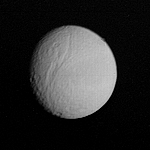 Tethys, with its giant rift valley Ithaca Chasma, from 1.2 million km.
Tethys, with its giant rift valley Ithaca Chasma, from 1.2 million km.- Fractured 'wispy terrain' on Dione's trailing hemisphere.
- The icy surface of Rhea is nearly saturated with impact craters.
- Titan's thick haze layer is shown in this enhanced Voyager 1 image.
- Layers of haze, composed of complex organic compounds, covering Saturn's satellite Titan.
Exit from the heliosphere




![The Pale Blue Dot image showing Earth from 6 billion kilometers (3.7 billion miles) appearing as a tiny dot (the bluish-white speck approximately halfway down the light band to the right) within the darkness of deep space.[41]](http://upload.wikimedia.org/wikipedia/commons/thumb/d/d2/PIA23645-Earth-PaleBlueDot-6Bkm-Voyager1-orig19900214-upd20200212.jpg/200px-PIA23645-Earth-PaleBlueDot-6Bkm-Voyager1-orig19900214-upd20200212.jpg)
On February 14, 1990, Voyager 1 took the first "family portrait" of the Solar System as seen from outside,[42] which includes the image of planet Earth known as Pale Blue Dot. Soon afterward, its cameras were deactivated to conserve energy and computer resources for other equipment. The camera software has been removed from the spacecraft, so it would now be complex to get them working again. Earth-side software and computers for reading the images are also no longer available.[5]
On February 17, 1998, Voyager 1 reached a distance of 69 AU (6.4 billion mi; 10.3 billion km) from the Sun and overtook Pioneer 10 as the most distant spacecraft from Earth.[43][44] Travelling at about 17 km/s (11 mi/s),[45] it has the fastest heliocentric recession speed of any spacecraft.[46]
As Voyager 1 headed for interstellar space, its instruments continued to study the Solar System. Jet Propulsion Laboratory scientists used the plasma wave experiments aboard Voyager 1 and 2 to look for the heliopause, the boundary at which the solar wind transitions into the interstellar medium.[47] As of 2013[update], the probe was moving with a relative velocity to the Sun of about 61,197 kilometers per hour (38,026 mph).[48] With the velocity the probe is currently maintaining, Voyager 1 is traveling about 523 million km (325 million mi) per year,[49] or about one light-year per 18,000 years.
Termination shock

Scientists at the Johns Hopkins University Applied Physics Laboratory believe that Voyager 1 entered the termination shock in February 2003.[50] This marks the point where the solar wind slows to subsonic speeds. Some other scientists expressed doubt, discussed in the journal Nature of November 6, 2003.[51] The issue would not be resolved until other data became available, since Voyager 1's solar-wind detector ceased functioning in 1990. This failure meant that termination shock detection would have to be inferred from the data from the other instruments on board.[52][53][54]
In May 2005, a NASA press release said that the consensus was that Voyager 1 was then in the heliosheath.[55] In a scientific session at the American Geophysical Union meeting in New Orleans on May 25, 2005, Dr. Ed Stone presented evidence that the craft crossed the termination shock in late 2004.[56] This event is estimated to have occurred on December 15, 2004, at a distance of 94 AU (8,700 million mi) from the Sun.[56][57]
Heliosheath
On March 31, 2006, amateur radio operators from AMSAT in Germany tracked and received radio waves from Voyager 1 using the 20-meter (66 ft) dish at Bochum with a long integration technique. Retrieved data was checked and verified against data from the Deep Space Network station at Madrid, Spain.[58] This seems to be the first such amateur tracking of Voyager 1.[58]
It was confirmed on December 13, 2010, that Voyager 1 had passed the reach of the radial outward flow of the solar wind, as measured by the Low Energy Charged Particle device. It is suspected that solar wind at this distance turns sideways because of interstellar wind pushing against the heliosphere. Since June 2010, detection of solar wind had been consistently at zero, providing conclusive evidence of the event.[59][60] On this date, the spacecraft was approximately 116 AU (17.4 billion km; 10.8 billion mi) from the Sun.[61]
Voyager 1 was commanded to change its orientation to measure the sideways motion of the solar wind at that location in space in March 2011 (~33yr 6mo from launch). A test roll done in February had confirmed the spacecraft's ability to maneuver and reorient itself. The course of the spacecraft was not changed. It rotated 70 degrees counterclockwise with respect to Earth to detect the solar wind. This was the first time the spacecraft had done any major maneuvering since the Family Portrait photograph of the planets was taken in 1990. After the first roll the spacecraft had no problem in reorienting itself with Alpha Centauri, Voyager 1's guide star, and it resumed sending transmissions back to Earth. Voyager 1 was expected to enter interstellar space "at any time". Voyager 2 was still detecting outward flow of solar wind at that point but it was estimated that in the following months or years it would experience the same conditions as Voyager 1.[62][63]
The spacecraft was reported at 12.44° declination and 17.163 hours right ascension, and at an ecliptic latitude of 34.9° (the ecliptic latitude changes very slowly), placing it in the constellation Ophiuchus as observed from the Earth on May 21, 2011.[5]
On December 1, 2011, it was announced that Voyager 1 had detected the first Lyman-alpha radiation originating from the Milky Way galaxy. Lyman-alpha radiation had previously been detected from other galaxies, but because of interference from the Sun, the radiation from the Milky Way was not detectable.[64]
NASA announced on December 5, 2011, that Voyager 1 had entered a new region referred to as a "cosmic purgatory". Within this stagnation region, charged particles streaming from the Sun slow and turn inward, and the Solar System's magnetic field is doubled in strength as interstellar space appears to be applying pressure. Energetic particles originating in the Solar System decline by nearly half, while the detection of high-energy electrons from outside increases 100-fold. The inner edge of the stagnation region is located approximately 113 AU from the Sun.[65]
Heliopause
NASA announced in June 2012 that the probe was detecting changes in the environment that were suspected to correlate with arrival at the heliopause.[66] Voyager 1 had reported a marked increase in its detection of charged particles from interstellar space, which are normally deflected by the solar winds within the heliosphere from the Sun. The craft thus began to enter the interstellar medium at the edge of the Solar System.[67]
Voyager 1 became the first spacecraft to cross the heliopause in August 2012, then at a distance of 121 AU (1.12×1010 mi; 1.81×1010 km) from the Sun, although this was not confirmed for another year.[68][69][70][71][72]
As of September 2012, sunlight took 16.89 hours to get to Voyager 1 which was at a distance of 121 AU. The apparent magnitude of the Sun from the spacecraft was -16.3 (about 30 times brighter than the full Moon).[73] The spacecraft was traveling at 17.043 km/s (10.590 mi/s) relative to the Sun. It would need about 17,565 years at this speed to travel a light-year.[73] To compare, Proxima Centauri, the closest star to the Sun, is about 4.2 light-years (2.65×105 AU) distant. Were the spacecraft traveling in the direction of that star, 73,775 years would pass before Voyager 1 would reach it. (Voyager 1 is heading in the direction of the constellation Ophiuchus.[73])
In late 2012, researchers reported that particle data from the spacecraft suggested that the probe had passed through the heliopause. Measurements from the spacecraft revealed a steady rise since May in collisions with high energy particles (above 70 MeV), which are thought to be cosmic rays emanating from supernova explosions far beyond the Solar System, with a sharp increase in these collisions in late August. At the same time, in late August, there was a dramatic drop in collisions with low-energy particles, which are thought to originate from the Sun.[74]
Ed Roelof, space scientist at Johns Hopkins University and principal investigator for the Low-Energy Charged Particle instrument on the spacecraft, declared that "most scientists involved with Voyager 1 would agree that [these two criteria] have been sufficiently satisfied".[74] However, the last criterion for officially declaring that Voyager 1 had crossed the boundary, the expected change in magnetic field direction (from that of the Sun to that of the interstellar field beyond), had not been observed (the field had changed direction by only 2 degrees[69]), which suggested to some that the nature of the edge of the heliosphere had been misjudged.
On December 3, 2012, Voyager project scientist Ed Stone of the California Institute of Technology said, "Voyager has discovered a new region of the heliosphere that we had not realized was there. We're still inside, apparently. But the magnetic field now is connected to the outside. So it's like a highway letting particles in and out."[75] The magnetic field in this region was 10 times more intense than Voyager 1 encountered before the termination shock. It was expected to be the last barrier before the spacecraft exited the Solar System completely and entered interstellar space.[76][77][78]
Interstellar medium
In March 2013, it was announced that Voyager 1 might have become the first spacecraft to enter interstellar space, having detected a marked change in the plasma environment on August 25, 2012. However, until September 12, 2013, it was still an open question as to whether the new region was interstellar space or an unknown region of the Solar System. At that time, the former alternative was officially confirmed.[79][80]
In 2013 Voyager 1 was exiting the Solar System at a speed of about 3.6 AU (330 million mi; 540 million km) per year, while Voyager 2 is going slower, leaving the Solar System at 3.3 AU (310 million mi; 490 million km) per year.[81] Each year, Voyager 1 increases its lead over Voyager 2.
Voyager 1 reached a distance of 135 AU (12.5 billion mi; 20.2 billion km) from the Sun on May 18, 2016.[3] On September 5, 2017, that had increased to about 139.64 AU (12.980 billion mi; 20.890 billion km) from the Sun, or just over 19 light-hours; at that time, Voyager 2 was 115.32 AU (10.720 billion mi; 17.252 billion km) from the Sun.[3]
Its progress can be monitored at NASA's website (see § External links).[3]
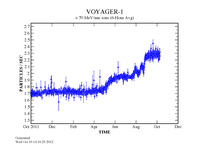 Plot showing a dramatic increase in the rate of cosmic ray particle detection by the Voyager 1 spacecraft (October 2011 through October 2012)
Plot showing a dramatic increase in the rate of cosmic ray particle detection by the Voyager 1 spacecraft (October 2011 through October 2012) Plot showing a dramatic decrease in the rate of solar wind particle detection by Voyager 1 (October 2011 through October 2012)
Plot showing a dramatic decrease in the rate of solar wind particle detection by Voyager 1 (October 2011 through October 2012)
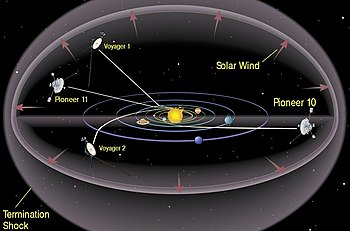
On September 12, 2013, NASA officially confirmed that Voyager 1 had reached the interstellar medium in August 2012 as previously observed. The generally accepted date of arrival is August 25, 2012 (approximately 10 days before the 35th anniversary of its launch), the date durable changes in the density of energetic particles were first detected.[70][71][72] By this point, most space scientists had abandoned the hypothesis that a change in magnetic field direction must accompany a crossing of the heliopause;[71] a new model of the heliopause predicted that no such change would be found.[82]
A key finding that persuaded many scientists that the heliopause had been crossed was an indirect measurement of an 80-fold increase in electron density, based on the frequency of plasma oscillations observed beginning on April 9, 2013,[71] triggered by a solar outburst that had occurred in March 2012[68] (electron density is expected to be two orders of magnitude higher outside the heliopause than within).[70] Weaker sets of oscillations measured in October and November 2012[80][83] provided additional data. An indirect measurement was required because Voyager 1's plasma spectrometer had stopped working in 1980.[72] In September 2013, NASA released recordings of audio transductions of these plasma waves, the first to be measured in interstellar space.[84]
While Voyager 1 is commonly spoken of as having left the Solar System simultaneously with having left the heliosphere, the two are not the same. The Solar System is usually defined as the vastly larger region of space populated by bodies that orbit the Sun. The craft is presently less than one-seventh the distance to the aphelion of Sedna, and it has not yet entered the Oort cloud, the source region of long-period comets, regarded by astronomers as the outermost zone of the Solar System.[69][80]
In October 2020, astronomers reported a significant unexpected increase in density in the space beyond the Solar System as detected by the Voyager 1 and Voyager 2 space probes. According to the researchers, this implies that "the density gradient is a large-scale feature of the VLISM (very local interstellar medium) in the general direction of the heliospheric nose".[85][86]
In May 2021, NASA reported on the continuous measurement, for the first time, of the density of material in interstellar space and, as well, the detection of interstellar sounds for the first time.[87]
In May 2022, NASA reported that Voyager 1 had begun transmitting "mysterious" and "peculiar" telemetric data to the Deep Space Network (DSN). It confirmed that the operational status of the craft remained unchanged, but that the issue stemmed from the Attitude Articulation and Control System (AACS). NASA's Jet Propulsion Laboratory (JPL) published a statement on May 18, 2022 that the AACS was functional but sending invalid data.[88][89] The problem was eventually traced to the AACS sending its telemetry through a computer that had been non-operational for years, resulting in data corruption. In August 2022, NASA transmitted a command to the AACS to utilize another computer, which resolved the problem. An investigation into what caused the initial switch is underway, though engineers have hypothesized that the AACS had executed a bad command from another onboard computer.[90][91]
Future of the probe
| Probe | Velocity () |
|---|---|
| Pioneer 10 | 11.8 km/s (2.49 au/yr) |
| Pioneer 11 | 11.1 km/s (2.34 au/yr) |
| Voyager 1 | 16.9 km/s (3.57 au/yr)[92] |
| Voyager 2 | 15.2 km/s (3.21 au/yr) |
| New Horizons | 12.6 km/s (2.66 au/yr) |
Remaining lifespan
![Image of Voyager 1's radio signal on February 21, 2013[93]](http://upload.wikimedia.org/wikipedia/commons/thumb/1/12/Voyager_1_Radio_Signal_21_Feb_2013.jpg/170px-Voyager_1_Radio_Signal_21_Feb_2013.jpg)
In December 2017, NASA successfully fired up all four of Voyager 1's trajectory correction maneuver (TCM) thrusters for the first time since 1980. The TCM thrusters will be used in the place of a degraded set of jets which were used to help keep the probe's antenna pointed towards the Earth. Use of the TCM thrusters will allow Voyager 1 to continue to transmit data to NASA for two to three more years.[94][95]
Due to the diminishing electrical power available, the Voyager team has had to prioritize which instruments to keep on and which to turn off. Heaters and other spacecraft systems have been turned off one by one as part of power management. The fields and particles instruments that are the most likely to send back key data about the heliosphere and interstellar space have been prioritized to keep operating. Engineers expect the spacecraft to continue operating at least one science instrument until around 2025.[96]
| Year | End of specific capabilities as a result of the available electrical power limitations |
|---|---|
| 1998 | Termination of Ultraviolet Spectrometer (UVS)[97] |
| 2007 | Termination of plasma subsystem (PLS)[98] |
| 2008 | Power off Planetary Radio Astronomy Experiment (PRA)[98] |
| 2016 | Termination of scan platform and Ultraviolet Spectrometer (UVS) observations[99] |
| Unknown date | Start shutdown of science instruments (as of October 18, 2010[update] the order is undecided, however the Low-Energy Charged Particles, Cosmic Ray Subsystem, Magnetometer, and Plasma Wave Subsystem instruments are expected to still be operating)[98] |
| Unknown date | Termination of Data Tape Recorder (DTR) operations (limited by ability to capture 1.4 kbit/s data using a 70 m/34 m antenna array; this is the minimum rate at which the DTR can read out data).[98] |
| Unknown date | Termination of gyroscopic operations (previously 2017, but backup thrusters active for continuation of gyroscopic operations.)[98] |
| 2025–2036 | Will no longer be able to power even a single instrument. After 2036, both probes will be out of range of the Deep Space Network.[12] |
Far future
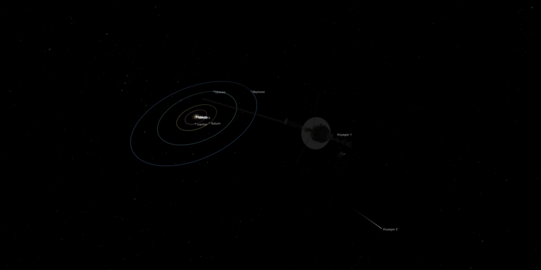 Simulated view of Voyager 1 relative to the Solar System on August 2, 2018.
Simulated view of Voyager 1 relative to the Solar System on August 2, 2018. Simulated view of the Voyager probes relative to the Solar System and heliopause on August 2, 2018.
Simulated view of the Voyager probes relative to the Solar System and heliopause on August 2, 2018.- In about 50,000 years Voyager 1 will be as distant as several nearby stars
Provided Voyager 1 does not collide with anything and is not retrieved, the New Horizons space probe will never pass it, despite being launched from Earth at a higher speed than either Voyager spacecraft. The Voyager spacecraft benefited from multiple planetary flybys to increase its heliocentric velocities, whereas New Horizons received only a single such boost, from its Jupiter flyby. As of 2018[update], New Horizons is traveling at about 14 km/s (8.7 mi/s), 3 km/s (1.9 mi/s) slower than Voyager 1 and is still slowing down.[100]
Voyager 1 is expected to reach the theorized Oort cloud in about 300 years[101][102] and take about 30,000 years to pass through it.[69][80] Though it is not heading towards any particular star, in about 40,000 years, it will pass within 1.6 light-years (0.49 parsecs) of the star Gliese 445, which is at present in the constellation Camelopardalis and 17.1 light-years from Earth.[103] That star is generally moving towards the Solar System at about 119 km/s (430,000 km/h; 270,000 mph).[103] NASA says that "The Voyagers are destined—perhaps eternally—to wander the Milky Way."[104] In 300,000 years, it will pass within less than 1 light year of the M3V star TYC 3135-52-1.[105]
Golden record

Each Voyager space probe carries a gold-plated audio-visual disc, should the spacecraft ever be found by intelligent life forms from other planetary systems.[106] The disc carries photos of the Earth and its lifeforms, a range of scientific information, spoken greetings from people such as the Secretary-General of the United Nations and the President of the United States and a medley, "Sounds of Earth," that includes the sounds of whales, a baby crying, waves breaking on a shore, and a collection of music including works by Wolfgang Amadeus Mozart, Blind Willie Johnson, Chuck Berry and Valya Balkanska. Other Eastern and Western classics are included, as well as various performances of indigenous music from around the world. The record also contains greetings in 55 different languages.[107]
See also
- The Farthest, a 2017 documentary on the Voyager program
- Interstellar probe
- List of artificial objects leaving the Solar System
- List of missions to the outer planets
- Local Interstellar Cloud
- Space exploration
- Specific orbital energy of Voyager 1
- Timeline of artificial satellites and space probes
- Voyager 2
References
- "Voyager 1". NSSDC Master Catalog. NASA/NSSDC. Retrieved August 21, 2013.
- "Voyager 1". N2YO. Retrieved August 21, 2013.
- "Voyager - Mission Status". Jet Propulsion Laboratory. National Aeronautics and Space Administration. Retrieved November 21, 2021.
- "Voyager 1". BBC Solar System. Archived from the original on February 3, 2018. Retrieved September 4, 2018.
- "Voyager – Frequently Asked Questions". NASA. February 14, 1990. Archived from the original on October 21, 2021. Retrieved August 4, 2017.
- "New Horizons conducts flyby of Pluto in historic Kuiper Belt encounter". July 12, 2015. Retrieved September 2, 2015.
- "What If Voyager Had Explored Pluto?". Retrieved September 2, 2015.
- "Interstellar Mission". NASA Jet Propulsion Laboratory. Retrieved August 24, 2020.
- Barnes, Brooks (September 12, 2013). "In a Breathtaking First, NASA Craft Exits the Solar System". New York Times. Retrieved September 12, 2013.
- Claven, Whitney (July 7, 2014). "Sun Sends More 'Tsunami Waves' to Voyager 1". NASA. Retrieved July 8, 2014.
- Wall, Mike (December 1, 2017). "Voyager 1 Just Fired Up its Backup Thrusters for the 1st Time in 37 Years". Space.com. Retrieved December 3, 2017.
- "Voyager – Frequently Asked Questions". Jet Propulsion Laboratory. Retrieved July 30, 2020.
- "1960s". JPL. Archived from the original on December 8, 2012. Retrieved August 18, 2013.
- "The Pioneer missions". NASA. 2007. Retrieved August 19, 2013.
- "Preview Screening: The Farthest - Voyager in Space". informal.jpl.nasa.gov. NASA Museum Alliance. August 2017. Retrieved August 18, 2019.
supermarket aluminum foil added at the last minute to protect the craft from radiation
- Mack, Pamela (1998). "Chapter 11". From engineering science to big science: The NACA and NASA Collier Trophy research project winners. History Office. p. 251. ISBN 978-0-16-049640-0.
- Landau, Elizabeth (October 2, 2013). "Voyager 1 becomes first human-made object to leave solar system". CNN. CNN. Retrieved May 29, 2014.
- "NASA Spacecraft Embarks on Historic Journey into Interstellar Space". NASA. September 12, 2013. Retrieved May 29, 2014.
NASA's Voyager 1 spacecraft officially is the first human-made object to venture into interstellar space.
- "Viking: Trailblazer for All Mars Research". NASA. June 22, 2006. Retrieved May 29, 2014.
All of these missions relied on Viking technologies. As it did for the Viking program team in 1976, Mars continues to hold a special fascination. Thanks to the dedication of men and women working at NASA centers across the country, the mysterious Mars of our past is becoming a much more familiar place.
- "VOYAGER 1:Host Information". JPL. 1989. Retrieved April 29, 2015.
- "High Gain Antenna". JPL. Retrieved August 18, 2013.
- Ludwig, Roger; Taylor, Jim (March 2002). "Voyager Telecommunications" (PDF). DESCANSO Design and Performance Summary Series. NASA/JPL. Retrieved September 16, 2013.
- "NASA News Press Kit 77–136". JPL/NASA. Retrieved December 15, 2014.
- Furlong, Richard R.; Wahlquist, Earl J. (1999). "U.S. space missions using radioisotope power systems" (PDF). Nuclear News. 42 (4): 26–34.
- "Spacecraft Lifetime". JPL. Retrieved August 19, 2013.
- "pds-rings". Retrieved May 23, 2015.
- Tomayko, James (April 1987). Computers in Spaceflight: The NASA Experience. NASA. Bibcode:1988csne.book.....T. Retrieved February 6, 2010.
- "au.af". Archived from the original on October 16, 2015. Retrieved May 23, 2015.
- "airandspace". Retrieved May 23, 2015.
- "Voyager 1 Narrow Angle Camera Description". NASA. Retrieved January 17, 2011.
- "Voyager 1 Wide Angle Camera Description". NASA. Retrieved January 17, 2011.
- Greicius, Tony (December 1, 2017). "Voyager 1 Fires Up Thrusters After 37 Years". NASA. Retrieved December 13, 2017.
- According to the Jet Propulsion Laboratory (JPL) status page
- "Encounter with Jupiter". NASA. Retrieved August 18, 2013.
- "Planetary voyage". NASA. Retrieved August 18, 2013.
- HORIZONS, JPL Solar System Dynamics (Ephemeris Type ELEMENTS; Target Body: Voyager n (spacecraft); Center: Sun (body center); Time Span: launch + 1 month to Jupiter encounter - 1 month)
- "Voyager - Images Voyager took of Jupiter". voyager.jpl.nasa.gov. Retrieved December 23, 2020.
- "Encounter with saturn". NASA. Retrieved August 29, 2013.
- Jim Bell (February 24, 2015). The Interstellar Age: Inside the Forty-Year Voyager Mission. Penguin Publishing Group. p. 93. ISBN 978-0-698-18615-6.
- David W. Swift (January 1, 1997). Voyager Tales: Personal Views of the Grand Tour. AIAA. p. 69. ISBN 978-1-56347-252-7.
- Staff (February 12, 2020). "Pale Blue Dot Revisited". NASA. Retrieved February 12, 2020.
- "Photo Caption". Public Information Office. Retrieved August 26, 2010.
- "Voyager 1 now most distant man-made object in space". CNN. February 17, 1998. Archived from the original on June 20, 2012. Retrieved July 1, 2012.
- Clark, Stuart (September 13, 2013). "Voyager 1 leaving solar system matches feats of great human explorers". The Guardian.
- Webb, Stephen (October 4, 2002). If the Universe is Teeming with Aliens … WHERE IS EVERYBODY?: Fifty Solutions to the Fermi Paradox and the Problem of Extraterrestrial Life. ISBN 978-0-387-95501-8.
- Darling, David. "Fastest Spacecraft". Retrieved August 19, 2013.
- "Voyager 1 in heliopause". JPL. Retrieved August 18, 2013.
- "Mission Status". JPL. Retrieved February 14, 2020.
- Wall, Mike (September 12, 2013). "It's Official! Voyager 1 Spacecraft Has Left Solar System". Space.com. Retrieved May 30, 2014.
- Tobin, Kate (November 5, 2003). "Spacecraft reaches edge of Solar System". CNN. Retrieved August 19, 2013.
- Fisk, Len A. (2003). "Planetary Science: Over the edge?" (PDF). Nature. 426 (6962): 21–2. Bibcode:2003Natur.426...21F. doi:10.1038/426021a. PMID 14603294.
- Krimigis, S. M.; Decker, R. B.; Hill, M. E.; Armstrong, T. P.; Gloeckler, G.; Hamilton, D. C.; Lanzerotti, L. J.; Roelof, E. C. (2003). "Voyager 1 exited the solar wind at a distance of ~85 au from the Sun". Nature. 426 (6962): 45–8. Bibcode:2003Natur.426...45K. doi:10.1038/nature02068. PMID 14603311. S2CID 4393867.
- McDonald, Frank B.; Stone, Edward C.; Cummings, Alan C.; Heikkila, Bryant; Lal, Nand; Webber, William R. (2003). "Enhancements of energetic particles near the heliospheric termination shock". Nature. 426 (6962): 48–51. Bibcode:2003Natur.426...48M. doi:10.1038/nature02066. PMID 14603312. S2CID 4387317.
- Burlaga, L. F. (2003). "Search for the heliosheath with Voyager 1 magnetic field measurements" (PDF). Geophysical Research Letters. 30 (20): n/a. Bibcode:2003GeoRL..30.2072B. doi:10.1029/2003GL018291.
- "Voyager Enters Solar System's Final Frontier". NASA. May 24, 2005. Retrieved August 7, 2007.
- "Voyager crosses termination shock". Retrieved August 29, 2013.
- "Voyager Timeline". NASA/JPL. February 2013. Retrieved December 2, 2013.
- "ARRL article" (in German). AMSAT-DL. Archived from the original on October 14, 2006. "ARRL article".
- "Voyager 1 Sees Solar Wind Decline". NASA. December 13, 2010. Archived from the original on June 14, 2011. Retrieved September 16, 2013.
- Krimigis, S. M.; Roelof, E. C.; Decker, R. B.; Hill, M. E. (2011). "Zero outward flow velocity for plasma in a heliosheath transition layer". Nature. 474 (7351): 359–361. Bibcode:2011Natur.474..359K. doi:10.1038/nature10115. PMID 21677754. S2CID 4345662.
- Amos, Jonathan (December 14, 2010). "Voyager near Solar System's edge". BBC News. Retrieved December 21, 2010.
- NASA. "Voyager – The Interstellar Mission". NASA. Retrieved September 16, 2013.
- "Voyager: Still dancing 17 billion km from Earth". BBC News. March 9, 2011.
- "Voyager Probes Detect "invisible" Milky Way Glow". National Geographic. December 1, 2011. Retrieved December 4, 2011.
- "Spacecraft enters 'cosmic purgatory'". CNN. December 6, 2011. Retrieved December 7, 2011.
- "NASA Voyager 1 Spacecraft Nears Interstellar Space". Space.com. June 18, 2012. Retrieved August 19, 2013.
- "Data From NASA's Voyager 1 Point to Interstellar Future". NASA. June 14, 2012. Retrieved June 16, 2012.
- Cook, J.-R. C.; Agle, D.C.; Brown, D. (September 12, 2013). "NASA Spacecraft Embarks on Historic Journey into Interstellar Space". NASA. Retrieved September 14, 2013.
- Ghose, Tia (September 13, 2013). "Voyager 1 Really Is in Interstellar Space: How NASA Knows". Space.com. TechMedia Network. Retrieved September 14, 2013.
- Cowen, R. (2013). "Voyager 1 has reached interstellar space". Nature. doi:10.1038/nature.2013.13735. S2CID 123728719.
- Kerr, R. A. (2013). "It's Official—Voyager Has Left the Solar System". Science. 341 (6151): 1158–1159. Bibcode:2013Sci...341.1158K. doi:10.1126/science.341.6151.1158. PMID 24030991.
- Gurnett, D. A.; Kurth, W. S.; Burlaga, L. F.; Ness, N. F. (2013). "In Situ Observations of Interstellar Plasma with Voyager 1". Science. 341 (6153): 1489–1492. Bibcode:2013Sci...341.1489G. doi:10.1126/science.1241681. PMID 24030496. S2CID 206550402.
- Peat, Chris (September 9, 2012). "Spacecraft escaping the Solar System". Heavens-Above. Retrieved March 16, 2014.
- Wolchover, Natalie (October 9, 2012). "Did NASA's Voyager 1 Spacecraft Just Exit the Solar System?". livescience. Retrieved August 20, 2013.
- Matson, John (December 4, 2012). "Despite Tantalizing Hints, Voyager 1 Has Not Crossed into the Interstellar Medium". Scientific American. Retrieved August 20, 2013.
- "Voyager 1 Can 'Taste' the Interstellar Shore". Discovery News. Discovery Channel. December 3, 2012. Retrieved September 16, 2013.
- Oakes, Kelly (December 3, 2012). "Voyager 1 is still not out of the Solar System". Basic Space Blog. Scientific American. Retrieved September 16, 2013.
- "Voyager 1 probe leaving Solar System reaches 'magnetic highway' exit". Daily News & Analysis. Reuters. December 4, 2012. Retrieved December 4, 2012.
- "Voyager 1 has entered a new region of space, sudden changes in cosmic rays indicate". American Geophysical Union. March 20, 2013. Archived from the original on March 22, 2013.
- Cook, J.-R (September 12, 2013). "How Do We Know When Voyager Reaches Interstellar Space?". NASA / Jet Propulsion Lab. Retrieved September 15, 2013.
- "Voyager - Fast Facts". voyager.jpl.nasa.gov.
- Swisdak, M.; Drake, J. F.; Opher, M. (2013). "A Porous, Layered Heliopause". The Astrophysical Journal. 774 (1): L8. arXiv:1307.0850. Bibcode:2013ApJ...774L...8S. doi:10.1088/2041-8205/774/1/L8. S2CID 118459113.
- Morin, Monte (September 12, 2013). "NASA confirms Voyager 1 has left the Solar System". Los Angeles Times.
- "Voyage 1 Records "Sounds" of Interstellar Space". Space.com. Retrieved December 20, 2013.
- Starr, Michelle (October 19, 2020). "Voyager Spacecraft Detect an Increase in The Density of Space Outside The Solar System". ScienceAlert. Retrieved October 19, 2020.
- Kurth, W.S.; Gurnett, D.A. (August 25, 2020). "Observations of a Radial Density Gradient in the Very Local Interstellar Medium by Voyager 2". The Astrophysical Journal Letters. 900 (1): L1. Bibcode:2020ApJ...900L...1K. doi:10.3847/2041-8213/abae58. S2CID 225312823. Retrieved October 19, 2020.
- Hatfield, Miles; Cofield, Calla (May 11, 2021). "As NASA's Voyager 1 Surveys Interstellar Space, Its Density Measurements Are Making Waves". NASA. Retrieved May 11, 2021.
- Kooser, Amanda. "NASA's Voyager 1 Space Probe From the '70s Troubled by Mysterious Glitch". CNET. Retrieved May 24, 2022.
- "Humanity's most distant spacecraft is sending back weird signals from beyond our solar system". MSN. Retrieved May 24, 2022.
- Tariq Malik (August 30, 2022). "NASA solves Voyager 1 data glitch mystery, but finds another". Space.com. Retrieved September 1, 2022.
- Greicius, Tony (August 30, 2022). "Engineers Solve Data Glitch on NASA's Voyager 1". NASA. Retrieved September 1, 2022.
- Voyager Fast Facts
- "Voyager Signal Spotted By Earth Radio Telescopes". NASA. NASA TV. September 5, 2013. Retrieved May 20, 2015.
- "Voyager 1 spacecraft thrusters fire up after decades idle". The Irish Times. December 4, 2017.
- "Voyager 1 Fires Up Thrusters After 37 Years". NASA. December 1, 2017.
- "Voyager - Frequently Asked Questions". voyager.jpl.nasa.gov. Retrieved June 26, 2020.
- "Voyager - Mission Status". NASA.
- "Voyager: Operations Plan to the End Mission". NASA.
- "Voyager - Mission Status". voyager.jpl.nasa.gov.
- "New Horizons Salutes Voyager". New Horizons. August 17, 2006. Archived from the original on November 13, 2014. Retrieved November 3, 2009.
- "Catalog Page for PIA17046". Photo Journal. NASA. Retrieved April 27, 2014.
- "It's Official: Voyager 1 Is Now In Interstellar Space". UniverseToday. September 12, 2013. Retrieved April 27, 2014.
- "Voyager – Mission – Interstellar Mission". NASA. August 9, 2010. Retrieved March 17, 2011.
- "Future". NASA. Retrieved October 13, 2013.
- Bailer-Jones, Coryn A. L.; Farnocchia, Davide (April 3, 2019). "Future stellar flybys of the Voyager and Pioneer spacecraft". Research Notes of the AAS. 3 (4): 59. arXiv:1912.03503. Bibcode:2019RNAAS...3...59B. doi:10.3847/2515-5172/ab158e. S2CID 134524048.
- Ferris, Timothy (May 2012). "Timothy Ferris on Voyagers' Never-Ending Journey". Smithsonian Magazine. Archived from the original on November 4, 2013. Retrieved August 19, 2013.
- "Voyager Golden record". JPL. Retrieved August 18, 2013.
External links
- NASA Voyager website
- Voyager 1 Mission Profile by NASA's Solar System Exploration
- Position of Voyager 1 (Live-Counter)
- Voyager 1 (NSSDC Master Catalog)
- Heavens-above.com: Spacecraft Escaping the Solar System – current positions and diagrams
- JPL Voyager Telecom Manual
- Voyager 1 Has Outdistanced the Solar Wind
- Gray, Meghan. "Voyager and Interstellar Space". Deep Space Videos. Brady Haran.
- WebGL-based 3D artist's view of Voyager @ SPACECRAFTS 3D
На других языках
[de] Voyager 1
Voyager 1 (englisch voyager ‚Reisender‘) ist eine Raumsonde der US-amerikanischen Raumfahrtbehörde NASA zur Erforschung des äußeren Planetensystems und des interstellaren Raums im Rahmen des Voyager-Programms. Sie wurde am 5. September 1977 vom Launch Complex 41 auf Cape Canaveral mit einer Titan-IIIE-Centaur-Rakete gestartet. Ihre identisch aufgebaute Schwestersonde Voyager 2 war bereits 16 Tage früher auf einer anderen Flugbahn gestartet. Voyager 1 flog zunächst die Planeten Jupiter und Saturn an und trat am 25. August 2012 als erstes von Menschen geschaffenes Objekt in den interstellaren Raum ein.[1][2]- [en] Voyager 1
[es] Voyager 1
La Voyager 1 es una sonda espacial robótica de 722 kilogramos, lanzada el 5 de septiembre de 1977, desde Cabo Cañaveral, Florida. Sigue operativa en la actualidad, prosiguiendo su misión extendida que es localizar y estudiar los límites del sistema solar, incluyendo el cinturón de Kuiper y más allá, así como explorar el espacio interestelar inmediato, hasta fin de misión. El 25 de agosto de 2012, a poco más de 19 000 millones de kilómetros del Sol o 122 UA, la sonda dejó atrás la heliopausa, siendo la primera en alcanzar el espacio interestelar.[1] Su misión original era visitar Júpiter y Saturno. Fue la primera sonda en proporcionar imágenes detalladas de los satélites de esos planetas.[2] A una distancia de 153,14 UA (22 909 417 919 km) del Sol, en junio de 2021,[3] es la nave espacial más alejada de la Tierra y junto a la Voyager 2 en el espacio interestelar, pero aún sin salir del sistema solar, quedándole unos 17 702 años aproximadamente para salir de la nube de Oort, en la que entrará dentro de unos 300 años.[ru] Вояджер-1
«Вояджер-1» (англ. Voyager-1) — американский космический зонд, исследующий Солнечную систему с 5 сентября 1977 года. Основная миссия космической программы «Вояджер» заключалась в исследовании Юпитера и Сатурна. «Вояджер-1» стал первым космическим зондом, который сделал детальные снимки спутников этих планет. По завершении основной миссии он приступил к выполнению дополнительной миссии по исследованию отдалённых регионов Солнечной системы, включая пояс Койпера и границу гелиосферы.Другой контент может иметь иную лицензию. Перед использованием материалов сайта WikiSort.org внимательно изучите правила лицензирования конкретных элементов наполнения сайта.
WikiSort.org - проект по пересортировке и дополнению контента Википедии













